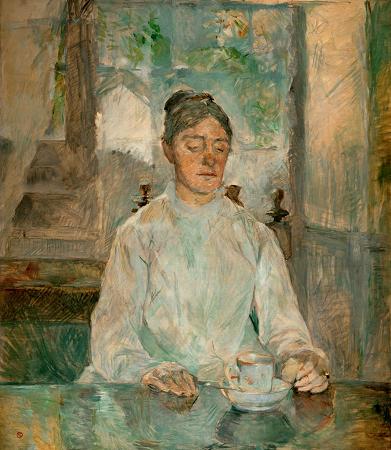Henri de Toulouse-Lautrec (1864 - 1901). Henri Marie Raymond de Toulouse-Lautrec-Monfa, commonly known as just Henri de Toulouse-Lautrec, was a French painter, printmaker, draughtsman, caricaturist, and illustrator whose immersion in the colourful and theatrical life of Paris in the late 19th century allowed him to produce a collection of enticing, elegant, and provocative images of the modern, sometimes decadent, affairs of those times. Toulouse-Lautrec is among the best-known painters of the Post-Impressionist period, with Paul Cézanne, Vincent van Gogh, and Paul Gauguin. In a 2005 auction at Christie's auction house, La Blanchisseuse, his early painting of a young laundress, sold for US$22.4 million and set a new record for the artist for a price at auction. Henri Marie Raymond de Toulouse-Lautrec-Monfa was born at the Hôtel du Bosc in Albi, Tarn, in the Midi-Pyrénées region of France, the firstborn child of Alphonse Charles Comte de Toulouse-Lautrec-Monfa and his wife Adèle Zoë Tapié de Celeyran. The last part of his name means he was a member of an aristocratic family. His younger brother was born in 1867, but died the following year. Both sons enjoyed the titres de courtoisie of Comte and had Henri outlived his father, he would have been accorded the family title of Comte de Toulouse-Lautrec. After the death of his brother, Toulouse-Lautrec's parents separated and a nanny eventually took care of him. At the age of eight, Toulouse-Lautrec went to live with his mother in Paris where he drew sketches and caricatures in his exercise workbooks. The family quickly realized that his talents lay in drawing and painting. A friend of his father, René Princeteau, visited sometimes to give informal lessons. Some of Toulouse-Lautrec's early paintings are of horses, a speciality of Princeteau, and a subject Lautrec revisited in his Circus Paintings. In 1875, Toulouse-Lautrec returned to Albi because his mother had concerns about his health. He took thermal baths at Amélie-les-Bains, and his mother consulted doctors in the hope of finding a way to improve her son's growth and development. Toulouse-Lautrec's parents, the Comte and Comtesse, were first cousins, and he had congenital health conditions sometimes attributed to a family history of inbreeding. At the age of 13, Toulouse-Lautrec fractured his right femur. At 14, he fractured his left. The breaks did not heal properly. Modern physicians attribute this to an unknown genetic disorder, possibly pycnodysostosis, or a variant disorder along the lines of osteopetrosis, achondroplasia, or osteogenesis imperfecta. Rickets aggravated by praecox virilism has also been suggested. Afterwards, his legs ceased to grow, so that as an adult he was extremely short. He developed an adult-sized torso, while retaining his child-sized legs. Additionally, he is reported to have had hypertrophied genitals. Physically unable to participate in many activities enjoyed by males his age, Toulouse-Lautrec immersed himself in art. He became an important Post-Impressionist painter, art nouveau illustrator, and lithographer, and, through his works, recorded many details of the late-19th-century bohemian lifestyle in Paris. Toulouse-Lautrec contributed a number of illustrations to the magazine Le Rire during the mid-1890s. After initially failing college entrance exams, he passed his second attempt and completed his studies. During a stay in Nice, France, his progress in painting and drawing impressed Princeteau, who persuaded Toulouse-Lautrec's parents to let him return to Paris and study under the portrait painter Léon Bonnat. He moved to Paris in 1882. Toulouse-Lautrec's mother had high ambitions and, with the aim of her son becoming a fashionable and respected painter, used their family's influence to get him into Bonnat's studio. He was drawn to Montmartre, the area of Paris famous for its bohemian lifestyle and the haunt of artists, writers, and philosophers. Studying with Bonnat placed Toulouse-Lautrec in the heart of Montmartre, an area he rarely left over the next 20 years. After Bonnat took a new job, Toulouse-Lautrec moved to the studio of Fernand Cormon in 1882 and studied for a further five years and established the group of friends he kept for the rest of his life. At this time he met Émile Bernard and Vincent van Gogh. Cormon, whose instruction was more relaxed than Bonnat's, allowed his pupils to roam Paris, looking for subjects to paint. During this period, Toulouse-Lautrec had his first encounter with a prostitute, which led him to paint his first painting of a prostitute in Montmartre, a woman rumoured to be Marie-Charlet.
more...














